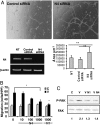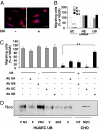Netrin-4 inhibits angiogenesis via binding to neogenin and recruitment of Unc5B
- PMID: 18719102
- PMCID: PMC2518829
- DOI: 10.1073/pnas.0804008105
Netrin-4 inhibits angiogenesis via binding to neogenin and recruitment of Unc5B
Abstract
Netrins are secreted molecules with roles in axon guidance and angiogenesis. We identified Netrin-4 as a gene specifically overexpressed in VEGF-stimulated endothelial cells (EC) in vitro as well as in vivo. Knockdown of Netrin-4 expression in EC increased their ability to form tubular structures on Matrigel. To identify which receptor is involved, we showed by quantitative RT-PCR that EC express three of the six Netrin-1 cognate receptors: neogenin, Unc5B, and Unc5C. In contrast to Netrin-1, Netrin-4 bound only to neogenin but not to Unc5B or Unc5C receptors. Neutralization of Netrin-4 binding to neogenin by blocking antibodies abolished the chemotactic effect of Netrin-4. Furthermore, the silencing of either neogenin or Unc5B abolished Netrin-4 inhibitory effect on EC migration, suggesting that both receptors are essential for its function in vitro. Coimmunoprecipitation experiments demonstrated that Netrin-4 increased the association between Unc5B and neogenin on VEGF- or FGF-2-stimulated EC. Finally, we showed that Netrin-4 significantly reduced pathological angiogenesis in Matrigel and laser-induced choroidal neovascularization models. Interestingly, Netrin-4, neogenin, and Unc5B receptor expression was up-regulated in choroidal neovessel EC after laser injury. Moreover, Netrin-4 overexpression delayed tumor angiogenesis in a model of s.c. xenograft. We propose that Netrin-4 acts as an antiangiogenic factor through binding to neogenin and recruitment of Unc5B.
Conflict of interest statement
The authors declare no conflict of interest.
Figures





Similar articles
-
Activation of the UNC5B receptor by Netrin-1 inhibits sprouting angiogenesis.Genes Dev. 2007 Oct 1;21(19):2433-47. doi: 10.1101/gad.437807. Genes Dev. 2007. PMID: 17908930 Free PMC article.
-
Netrin-4 induces lymphangiogenesis in vivo.Blood. 2010 Jul 1;115(26):5418-26. doi: 10.1182/blood-2009-11-252338. Epub 2010 Apr 20. Blood. 2010. PMID: 20407033 Free PMC article.
-
Netrin-1 promotes medulloblastoma cell invasiveness and angiogenesis, and demonstrates elevated expression in tumor tissue and urine of patients with pediatric medulloblastoma.Cancer Res. 2014 Jul 15;74(14):3716-26. doi: 10.1158/0008-5472.CAN-13-3116. Epub 2014 May 8. Cancer Res. 2014. PMID: 24812271 Free PMC article.
-
Netrin-4: Focus on Its Role in Axon Guidance, Tissue Stability, Angiogenesis and Tumors.Cell Mol Neurobiol. 2023 Jul;43(5):1663-1683. doi: 10.1007/s10571-022-01279-4. Epub 2022 Nov 9. Cell Mol Neurobiol. 2023. PMID: 36350538 Free PMC article. Review.
-
Netrin-integrin signaling in epithelial morphogenesis, axon guidance and vascular patterning.Cell Cycle. 2005 Mar;4(3):e131-5. Epub 2005 Mar 18. Cell Cycle. 2005. PMID: 15725728 Review.
Cited by
-
Therapeutic effects of topical netrin-4 in a corneal acute inflammatory model.Int J Ophthalmol. 2015 Apr 18;8(2):228-33. doi: 10.3980/j.issn.2222-3959.2015.02.03. eCollection 2015. Int J Ophthalmol. 2015. PMID: 25938032 Free PMC article.
-
Transcriptomic and Proteomic Analyses Reveal the Potential Mode of Action of Chondrocyte Sheets in Hyaline Cartilage Regeneration.Int J Mol Sci. 2019 Dec 24;21(1):149. doi: 10.3390/ijms21010149. Int J Mol Sci. 2019. PMID: 31878307 Free PMC article.
-
Axon Guidance-Related Factor FLRT3 Regulates VEGF-Signaling and Endothelial Cell Function.Front Physiol. 2019 Mar 12;10:224. doi: 10.3389/fphys.2019.00224. eCollection 2019. Front Physiol. 2019. PMID: 30930791 Free PMC article.
-
A Combined ULBP2 and SEMA5A Expression Signature as a Prognostic and Predictive Biomarker for Colon Cancer.J Cancer. 2017 Apr 9;8(7):1113-1122. doi: 10.7150/jca.17872. eCollection 2017. J Cancer. 2017. PMID: 28607584 Free PMC article.
-
Repulsive Guidance Molecule a Inhibits Angiogenesis by Downregulating VEGF and Phosphorylated Focal Adhesion Kinase In Vitro.Front Neurol. 2017 Sep 26;8:504. doi: 10.3389/fneur.2017.00504. eCollection 2017. Front Neurol. 2017. PMID: 29018403 Free PMC article.
References
-
- Campochiaro PA. Ocular versus extraocular neovascularization: Mirror images or vague resemblances. Invest Ophthalmol Vis Sci. 2006;47:462–474. - PubMed
-
- Eichmann A, Makinen T, Alitalo K. Neural guidance molecules regulate vascular remodeling and vessel navigation. Genes Dev. 2005;19:1013–1021. - PubMed
-
- Eichmann A, Le Noble F, Autiero M, Carmeliet P. Guidance of vascular and neural network formation. Curr Opin Neurobiol. 2005;15:108–115. - PubMed
-
- Klagsbrun M, Eichmann A. A role for axon guidance receptors and ligands in blood vessel development and tumor angiogenesis. Cytokine Growth Factor Rev. 2005;16:535–548. - PubMed
-
- Cirulli V, Yebra M. Netrins: Beyond the brain. Nat Rev Mol Cell Biol. 2007;8:296–306. - PubMed
Publication types
MeSH terms
Substances
LinkOut - more resources
Full Text Sources
Other Literature Sources
Molecular Biology Databases

